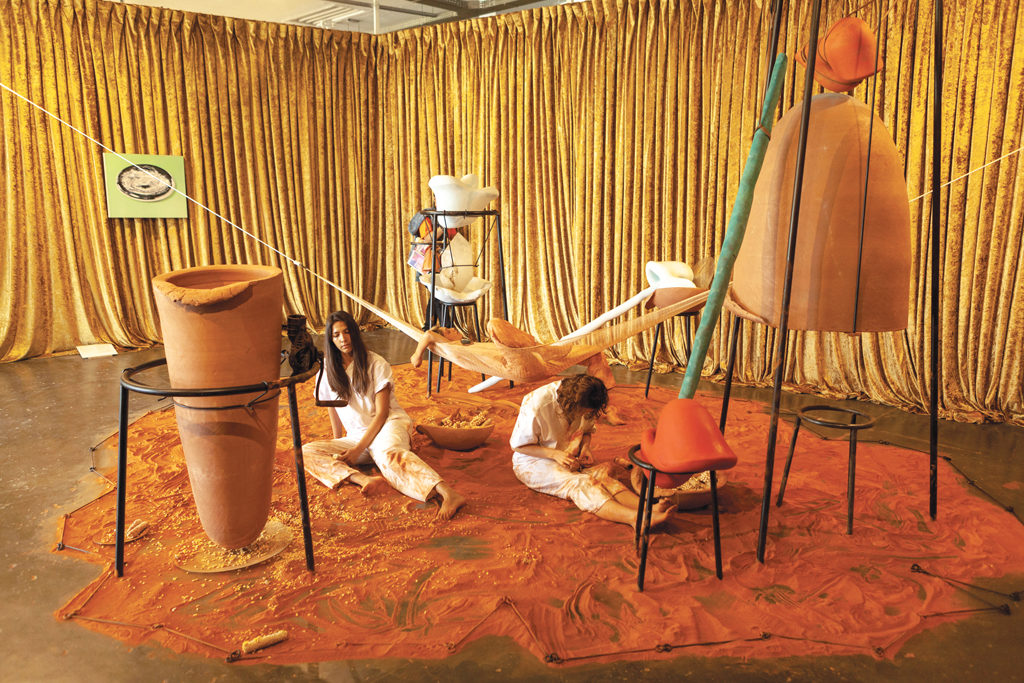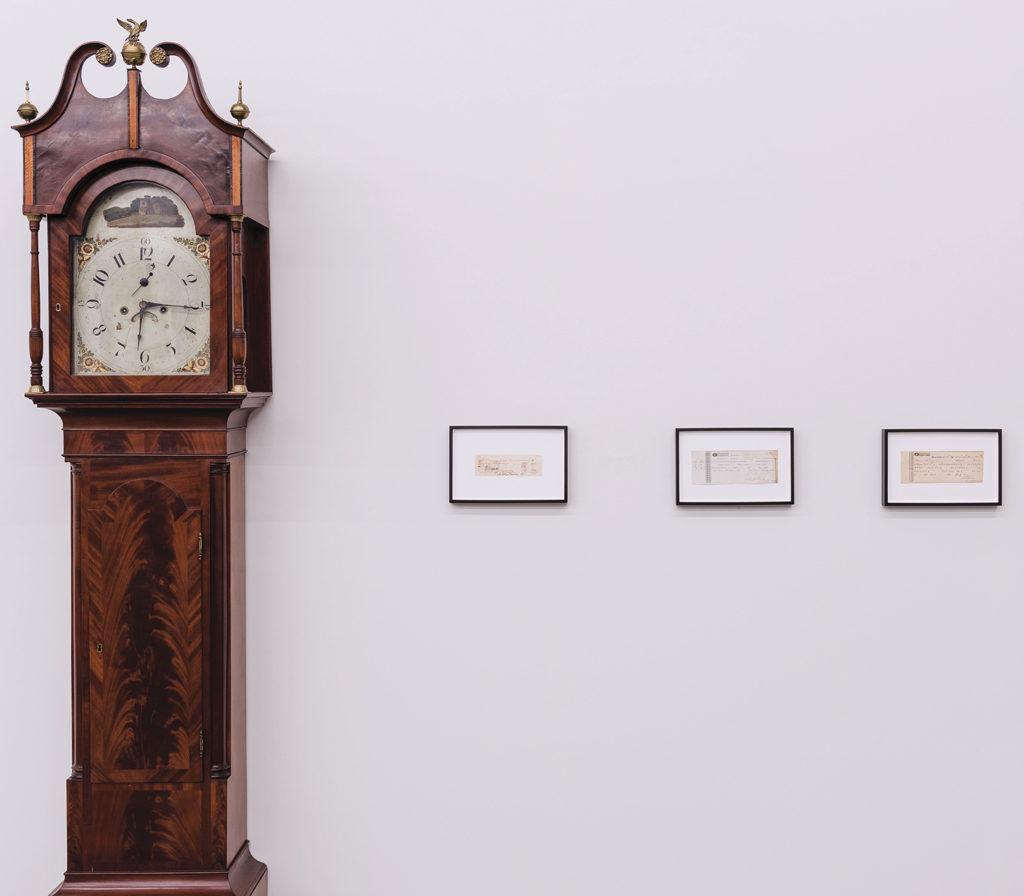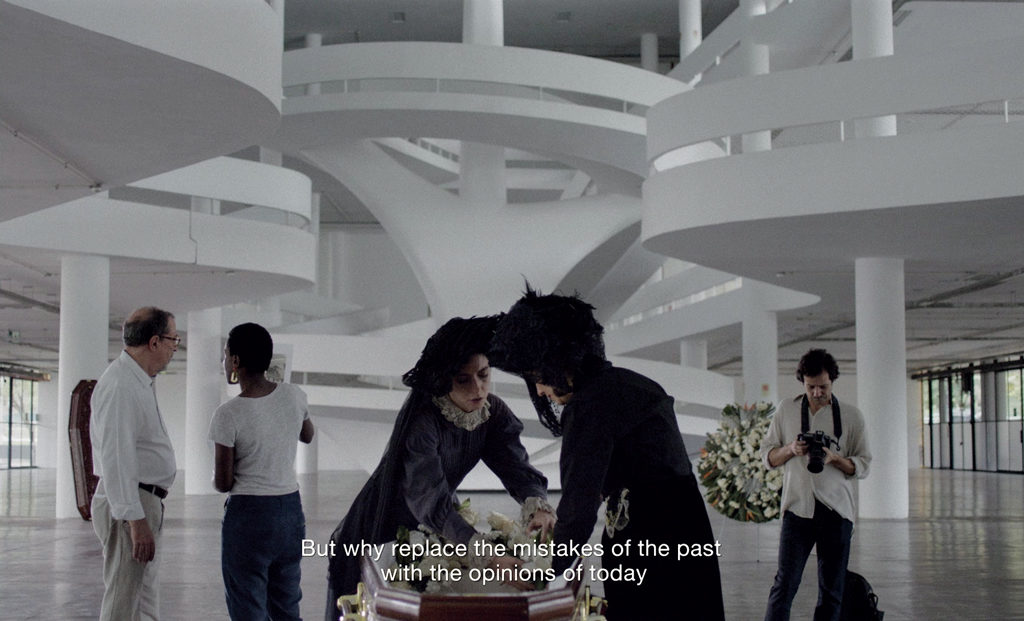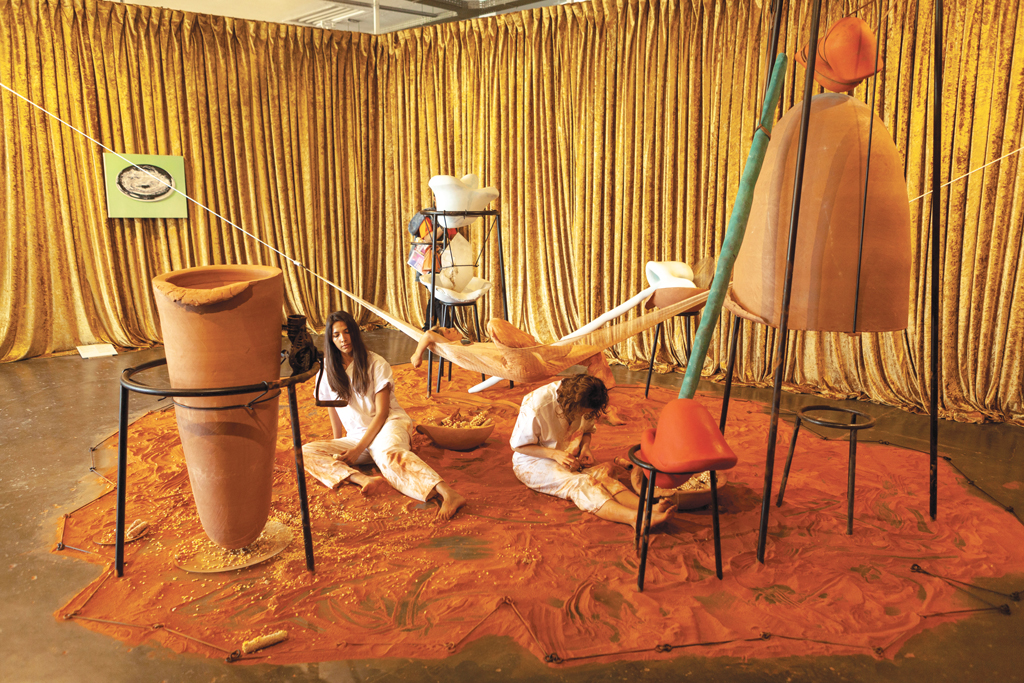[ad_1]

Tunga, Sem título, 2014, installation view, “The Infinite History of Things or the End of the Tragedy of One,” curated by Sofia Borges.
©PEDRO IVO TRASFERETT/FUNDAÇÃO BIENAL DE SÃO PAULO
The 33rd edition of the Bienal de São Paulo opened to the public in early September, just a few days after Brazil’s most important historic museum, the Museu Nacional, burned to the ground. The fire consumed its home, a 19th-century palace in Rio de Janeiro, in less than an hour, an agonizing scene broadcast live on television, pulling Brazilians away from the stupor of Sunday-night variety shows to witness part of their collective memory go up in flames. On the eve of the Bienal’s vernissage, in a twisted sequel to an already uncanny week, a divisive presidential candidate, Jair Bolsonaro, was stabbed in the belly as masses swirled around him during a rally, instantly turning the most controversial contender in this year’s race for the helm of Brasília into a kind of martyr less than a month before voters were to hit the polls.
Neglected over the past few decades and starved of cash, the Museu was a tragedy in waiting. Its conservators and the scientists who oversaw a trove of artifacts ranging from mummies to dinosaur skeletons and documents dating from colonial to imperial times—testaments to the very inception of Brazil as a nation—had been complaining about maintenance problems and fire hazards since early 2018. The institution’s 200th anniversary ironically also now marks its catastrophic disappearance.
Weeks later, Bolsonaro, the former Army captain who anchored his successful political campaign on what many regard as misogynistic, racist, and homophobic rants, became the next president of a country more divided than ever. Missing from presidential debates, and appearing instead in videos posted on social networks from his hospital bed as he recovered from his wounds, he remained the leading candidate, voicing the anger of right-wing extremists who flaunt their nostalgia for the days of the military regime.
These are just the latest developments in a country that has been dancing around the edge of a volcano. The temperature has been on the rise ever since massive protests flooded the streets and public squares of Latin America’s biggest and richest nation five years ago, in what started as a riot against rising fares on public transport. That wave of demonstrations led to the controversial impeachment of president Dilma Rousseff, submerging the country in political and economic chaos. Since then, violence has escalated, the new government has allowed censorship to flourish, with pressure to shut down a series of art shows deemed blasphemous or indecorous by newly emboldened religious fundamentalists, and the value of the national currency has shriveled.
But those who wander around the vast expanses of the Oscar Niemeyer–designed pavilion that has been home to the Bienal since the 1950s will feel none of this. The exhibition orchestrated by Gabriel Pérez-Barreiro has no pulse. It has turned its back on the outside world.
When Pérez-Barreiro was announced as chief curator of the Bienal last year, he was quick to say his edition would have no overarching theme, and that he would hand over control to seven artists to whom he would give free rein to select other artists. The resulting shows-within-a-show are gathered in small clusters around the cavernous, brutalist galleries in Ibirapuera park. In an attempt to be more democratic, Pérez-Barreiro has produced a sad, narcissistic exercise where smaller exhibitions, enacting artificial or parallel realities, become a dissonant archipelago of curatorial islands.

Cameron Rowland, Assessment, 2018, installation view, “To Our Parents,” curated by Alejandro Cesarco.
©LEO ELOY, ESTÚDIO GARAGEM/FUNDAÇÃO BIENAL DE SÃO PAULO
What emerges from this disjointed ensemble is a superficial appeal to the senses. Among folds of blue, violet, and golden velvet curtains, Sofia Borges, one of the seven artist curators, displays her own works alongside pieces by Leda Catunda, Sarah Lucas, Tunga, and other strong authors. It is a lush labyrinth where authorship is questioned. Working together, each artist photographed or painted pieces using a colleague’s work as the point of departure, so a photograph by Borges, for example, resurfaces later in the show in the contours of a painting by Antonio Malta Campos or Rafael Carneiro. In this way, pieces by different artists resemble one another, with a mirroring effect—the walls of fabric form equal rooms facing the void around Niemeyer’s monumental ramp. But they didn’t communicate. Instead, a work seen on one side faintly echoes its distant twin or doppelganger on the other, like a fading memory.
Borges’s layout is an attempt at mimicking the way thoughts transition between consciousness and unconsciousness. It is also a bold, albeit problematically gimmicky, curatorial conceit, different from that of her rather bland and blasé fellow curators, in the way it denies the modernist pavilion’s most coveted space. Each Bienal’s signature piece is normally set up in the towering void Borges filled with her low-lying labyrinth of curtains, as though striving to stress the fact that the entire show rejected grand gestures in favor of subtlety.
Farming out the curatorial work is not new for Pérez-Barreiro. He also sidestepped his role when he organized the Bienal do Mercosul, in Porto Alegre, Brazil, more than a decade ago, delegating command to third parties, but this most recent venture materialized in the wake of what appears to be a backlash against heavy-handed curating all around the world. The last Venice Biennale, organized by Christine Macel, also had no central concept and involved a series of monumental works strewn around the Arsenale in displays reminiscent of an art fair. The curator of the next one, Ralph Rugoff has also decided not to have a main theme. While the figure of curator as auteur may have run its course, the 33rd Bienal de São Paulo and its lack of a conceptual spine is proof positive of why curators are still needed.
Strong leadership might have given the Bienal a mood more resonant with its surroundings. While it is perhaps dangerous to wish for artists to reflect in their work the agonies of contemporary society with the sharpness and immediacy of a knife stuck in the belly, to recall Bolsonaro’s electoral incident, the escapist feel of this show couldn’t have been more out of sync with Brazil’s mood. At best, it is a feeble circus, a formalist arrangement of some quite beautiful works that scream they’re all art for art’s sake even in the face of looming chaos. In contrast, parallel shows in São Paulo’s museums and Kunsthalles, such as “AI-5 50 Anos,” at the Instituto Tomie Ohtake, and “Arte-Veículo,” at Sesc Pompeia, feature the most vociferous political art of both days gone by and today, in attempts to draw attention to what their curators see as a threat to democracy again rearing its head in a country that has endured two dictatorships. The modernist pavilion in Ibirapuera park thus becomes a rigid membrane dividing the world of heated political discourse from a land of fantasy inside.
“Ignorance is bliss” is an underlying motif in this rather tepid show, no more so than in the section organized by Mamma Andersson, who exhibits her own paintings of rosy bourgeois interiors laced with fierce tension and impending drama alongside Russian icons, obscure Swedish avant-garde films by Gunvor Nelson, drawings by Henry Darger, and work by painters in her general aesthetic orbit, such as Dick Bengtsson.
In much the same way, Waltercio Caldas, in a faraway gallery on the highest floor of the pavilion, arranges works by minimalist and conceptual artists that mirror and echo his cerebral approach to drawing and sculpture. Latin masters Antonio Dias, Armando Reverón, Jorge Oteiza, José Resende, Milton Dacosta, Sergio Camargo, and other luminaries, among them Bruce Nauman and Richard Hamilton, all feature in this celebration of Caldas’s artistic ego. Were it not so detached from the whole of the Bienal, it might make for a great show in and of itself, but there it feels like a dehydrated display of good taste among all the less successful endeavors.

Tamar Guimarães, O ensaio (The Rehearsal), still, 2018, film, 56 minutes.
COURTESY THE ARTIST AND FORTES D’ALOIA & GABRIEL, SÃO PAULO
Another noteworthy selection, for reasons good and bad, is Alejandro Cesarco’s cluster of artists—from the late Sturtevant, who’s never been shown in Brazil, to the incisive young New York artist Cameron Rowland, whose work could have been productively juxtaposed with other up-and-coming names in this country who also delve into complex, charged matters of race relations and government control. Cesarco’s selection gains from the conversation it established, as unintentional as it may have been, with Borges’s cluster, where the idea of authorship and originality came under attack. It suffers most, however, from a string of missed opportunities to present the exuberance and richness of some of these aesthetic pursuits in tandem with works within the Bienal itself that could have given them more heft.
In a Bienal where dialogue between artworks and sections is almost nonexistent, one accidental connection provided a moment of brilliance. While Rowland’s work, an installation in which a grandfather clock taken from a former plantation in the American South stands alongside records of taxes levied on slaves, remains isolated in Cesarco’s group show, some may see an echo of it in Tamar Guimarães’s film, O Ensaio, screened in a dark room curtained off from the vastness of the pavilion as one of the pieces in Pérez-Barreiro’s own selection of 12 artists. Guimarães’s work, like the American artist’s, also addresses the lethal inheritance of slavery. Shot mainly in Niemeyer’s building among the fragments that would later make up this Bienal, a group of actors is seen rehearsing a version of Epitaph of a Small Winner (1881), the Joaquim Maria Machado de Assis novel here used as a metaphor for changes in Brazilian society over time that further concentrated privilege in the hands of a lucky few. The film shows a young black woman as the director of this fictitious remake of Machado de Assis’s novel, focusing on her travails as she struggles to occupy a position of power overseeing an unruly group. In a rare exception to the rest of the show, Guimarães is making a trenchant, timely point, and doing so by harking back to a 19th-century literary jewel. It is a window looking onto the chaos outside this cloistered, convoluted Bienal de São Paulo.
A version of this story originally appeared in the Winter 2019 issue of ARTnews on page 112.
[ad_2]
Source link

